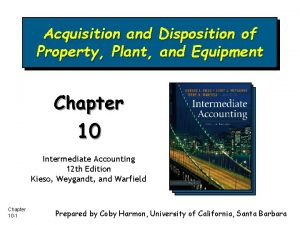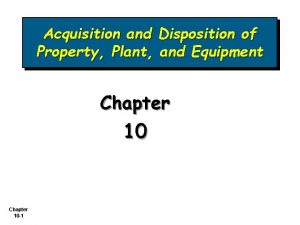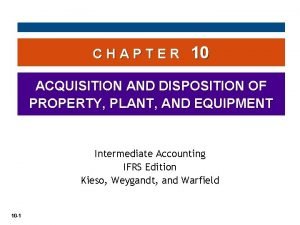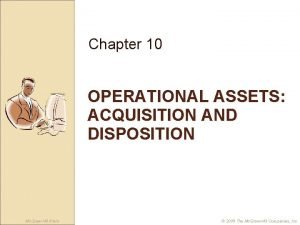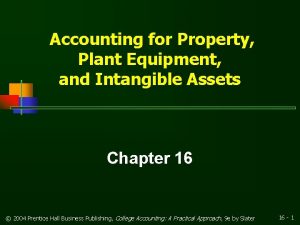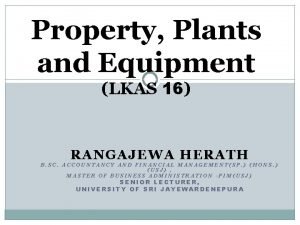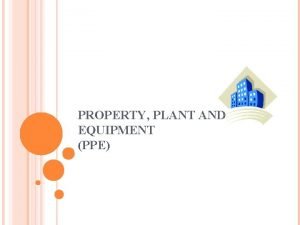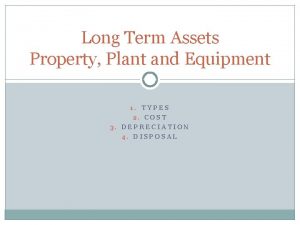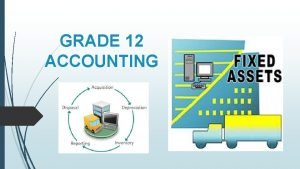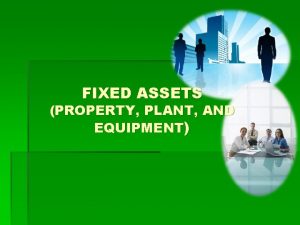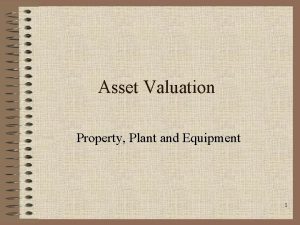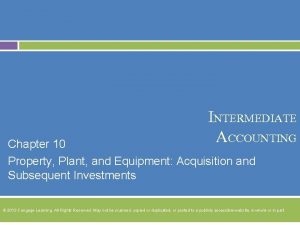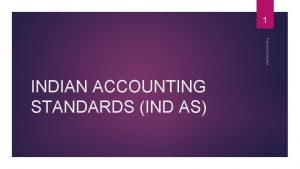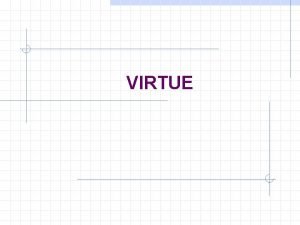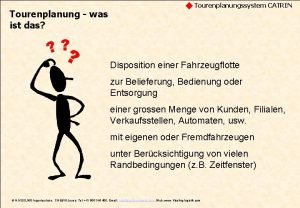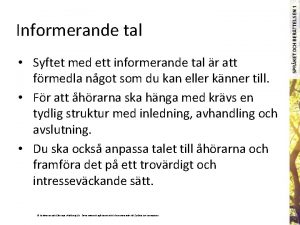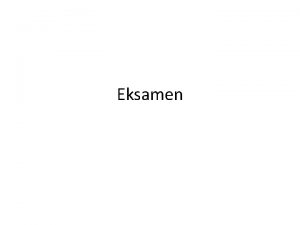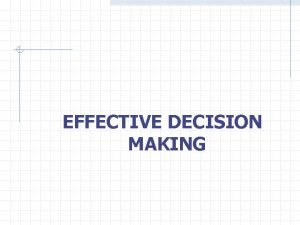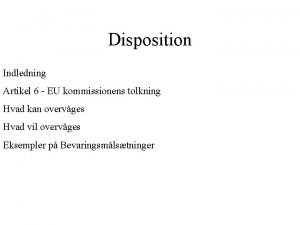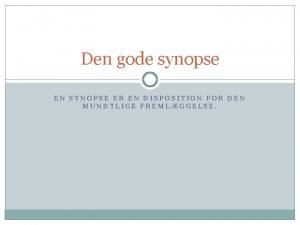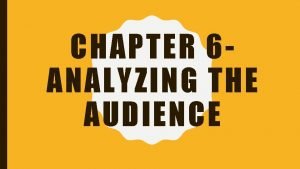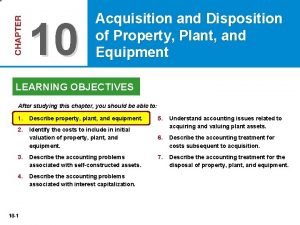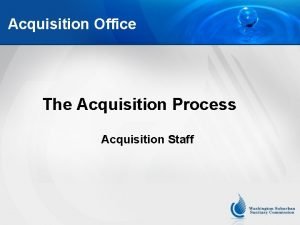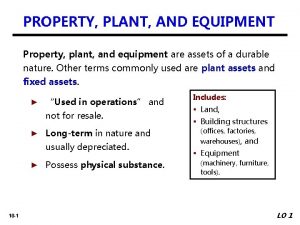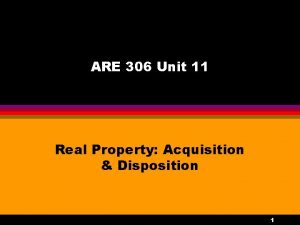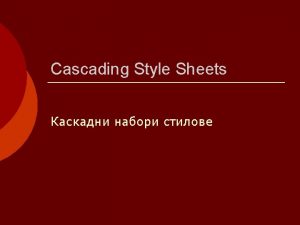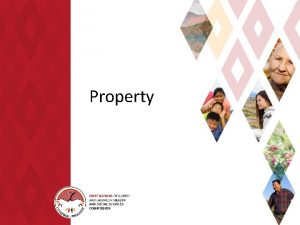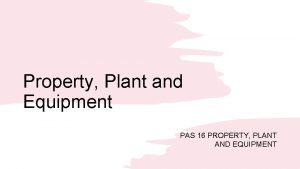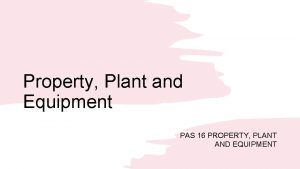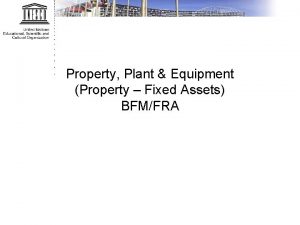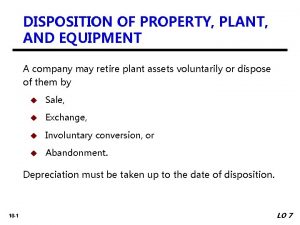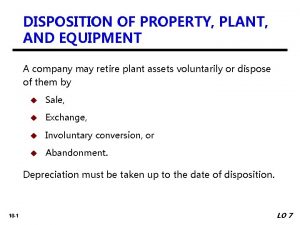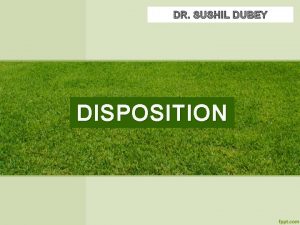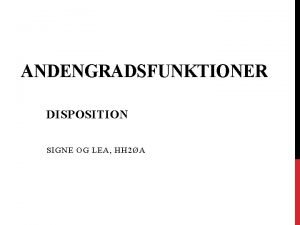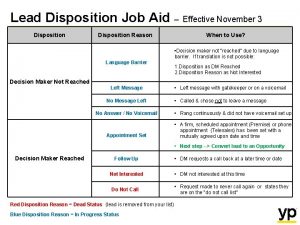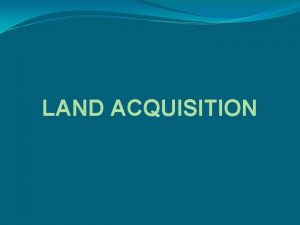10 Acquisition and Disposition of Property Plant and


































- Slides: 34

10 Acquisition and Disposition of Property, Plant, and Equipment Intermediate Accounting 14 th Edition 10 -1 Kieso, Weygandt, and Warfield

Property, Plant, and Equipment Property, plant, and equipment are assets of a durable nature. Other terms commonly used are plant assets and fixed assets. ► “Used in operations” and not for resale. § Land, § Building structures ► Long-term in nature and usually depreciated. (offices, factories, warehouses), and § Equipment ► Possess physical substance. 10 -2 Includes: (machinery, furniture, tools). LO 1 Describe property, plant, and equipment.

Acquisition of PP&E Historical cost measures the cash or cash equivalent price of obtaining the asset and bringing it to the location and condition necessary for its intended use. Main reasons for historical cost valuation: 10 -3 u Historical cost is reliable. u Companies should not anticipate gains and losses but should recognize gains and losses only when the asset is sold. LO 2 Identify the costs to include in initial valuation of property, plant, and equipment.

Acquisition of PP&E Cost of Land Includes all costs to acquire land ready it for use. Costs typically include: (1) purchase price; (2) closing costs, such as title to the land, attorney’s fees, and recording fees; (3) costs of grading, filling, draining, and clearing; (4) assumption of any liens, mortgages, or encumbrances on the property; and (5) additional land improvements that have an indefinite life. 10 -4 LO 2

Acquisition of PP&E Cost of Land Improvements with limited lives, such as private driveways, walks, fences, and parking lots, are recorded as Land Improvements and depreciated. 10 -5 u Land acquired and held for speculation is classified as an investment. u Land held by a real estate concern for resale should be classified as inventory. LO 2 Identify the costs to include in initial valuation of property, plant, and equipment.

Acquisition of PP&E Cost of Buildings Includes all costs related directly to acquisition or construction. Cost typically include: u materials, labor, and overhead costs incurred during construction and u 10 -6 professional fees and building permits. LO 2 Identify the costs to include in initial valuation of property, plant, and equipment.

Acquisition of PP&E Cost of Equipment Include all costs incurred in acquiring the equipment and preparing it for use. Costs typically include: 1) purchase price, 2) freight and handling charges, 3) insurance on the equipment while in transit, 4) cost of special foundations if required, 5) assembling and installation costs, and 6) costs of conducting trial runs. 10 -7 LO 2

Acquisition of PP&E E 10 -1 (variation): The expenditures and receipts below are related to land, land improvements, and buildings acquired for use in a business enterprise. Determine how the following should be classified: (a) Money borrowed to pay building contractor (b) Payment for construction from note proceeds Notes Payable Building (c) Cost of land fill and clearing Land (d) Delinquent real estate taxes on property assumed Land (e) Premium on 6 -month insurance policy during construction (f) 10 -8 Refund of 1 -month insurance premium because construction completed early Building (Building) LO 2

Acquisition of PP&E E 10 -1 (variation): The expenditures and receipts below are related to land, land improvements, and buildings acquired for use in a business enterprise. Determine how the following should be classified: (g) Architect’s fee on building Building (h) Cost of real estate purchased as a plant site (land $200, 000 and building $50, 000) Land (i) Commission fee paid to real estate agency Land (j) Installation of fences around property Land Improvements (k) Cost of razing and removing building Land (l) (Land) Proceeds from salvage of demolished building (m) Cost of parking lots and driveways (n) Cost of trees and shrubbery (permanent) 10 -9 Land Improvements Land LO 2

Acquisition of PP&E Self-Constructed Assets Costs typically include: (1) Materials and direct labor (2) Overhead can be handled in two ways: 1. Assign no fixed overhead 2. Assign a portion of all overhead to the construction process. Companies use the second method extensively. 10 -10 LO 3 Describe the accounting problems associated with self-constructed assets.

Valuation of PP&E Exchanges of Nonmonetary Assets Ordinarily accounted for on the basis of: u the fair value of the asset given up or u the fair value of the asset received, whichever is clearly more evident. Companies should recognize immediately any gains or losses on the exchange when the transaction has commercial substance. 10 -11 LO 5 Understand accounting issues related to acquiring and valuing plant assets.

Valuation of PP&E Meaning of Commercial Substance Exchange has commercial substance if the future cash flows change as a result of the transaction. That is, if the two parties’ economic positions change, the transaction has commercial substance. Illustration 10 -10 * If cash is 25% or more of the fair value of the exchange, recognize entire gain because earnings process is complete. 10 -12 LO 5 Understand accounting issues related to acquiring and valuing plant assets.

Valuation of PP&E Exchanges - Loss Situation Companies recognize a loss immediately whether the exchange has commercial substance or not. Rationale: Companies should not value assets at more than their cash equivalent price; if the loss were deferred, assets would be overstated. 10 -13 LO 5 Understand accounting issues related to acquiring and valuing plant assets.

Valuation of PP&E Illustration: Information Processing, Inc. trades its used machine for a new model at Jerrod Business Solutions Inc. The exchange has commercial substance. The used machine has a book value of $8, 000 (original cost $12, 000 less $4, 000 accumulated depreciation) and a fair value of $6, 000. The new model lists for $16, 000. Jerrod gives Information Processing a trade-in allowance of $9, 000 for the used machine. Information Processing computes the cost of the new asset as follows. Illustration 10 -11 10 -14 LO 5 Understand accounting issues related to acquiring and valuing plant assets.

Valuation of PP&E Illustration: Information Processing records this transaction as follows: Equipment 13, 000 Accumulated Depreciation—Equipment 4, 000 Loss on Disposal of Equipment 2, 000 Equipment Cash 12, 000 7, 000 Illustration 10 -12 Loss on Disposal 10 -15 LO 5 Understand accounting issues related to acquiring and valuing plant assets.

Valuation of PP&E Exchanges - Gain Situation Has Commercial Substance. Company usually records the cost of a nonmonetary asset acquired in exchange for another nonmonetary asset at the fair value of the asset given up, and immediately recognizes a gain. 10 -16 LO 5 Understand accounting issues related to acquiring and valuing plant assets.

Valuation of PP&E Illustration: Interstate Transportation Company exchanged a number of used trucks plus cash for a semi-truck. The used trucks have a combined book value of $42, 000 (cost $64, 000 less $22, 000 accumulated depreciation). Interstate’s purchasing agent, experienced in the second-hand market, indicates that the used trucks have a fair market value of $49, 000. In addition to the trucks, Interstate must pay $11, 000 cash for the semi-truck. Interstate computes the cost of the semi-truck as follows. Illustration 10 -13 10 -17 LO 5 Understand accounting issues related to acquiring and valuing plant assets.

Valuation of PP&E Illustration: Interstate records the exchange transaction as follows: Semi-truck 60, 000 Accumulated Depreciation—Trucks 22, 000 Trucks (used) Gain on disposal of Used Trucks Cash 64, 000 7, 000 11, 000 Illustration 10 -14 Gain on Disposal 10 -18 LO 5 Understand accounting issues related to acquiring and valuing plant assets.

Valuation of PP&E Exchanges - Gain Situation Lacks Commercial Substance—No Cash Received. Now assume that Interstate Transportation Company exchange lacks commercial substance. That is, the economic position of Interstate did not change significantly as a result of this exchange. In this case, Interstate defers the gain of $7, 000 and reduces the basis of the semi-truck. 10 -19 LO 5 Understand accounting issues related to acquiring and valuing plant assets.

Valuation of PP&E Illustration: Interstate records the exchange transaction as follows: Trucks (semi) 53, 000 Accumulated Depreciation—Trucks 22, 000 Trucks (used) 64, 000 Cash 11, 000 Illustration 10 -15 10 -20 LO 5 Understand accounting issues related to acquiring and valuing plant assets.

Valuation of PP&E Exchanges - Gain Situation Lacks Commercial Substance—Some Cash Received. When a company receives cash (sometimes referred to as “boot”) in an exchange that lacks commercial substance, it may immediately recognize a portion of the gain. The general formula for gain recognition when an exchange includes some cash is as follows: Illustration 10 -16 10 -21 LO 5 Understand accounting issues related to acquiring and valuing plant assets.

Valuation of PP&E Illustration: Queenan Corporation traded in used machinery with a book value of $60, 000 (cost $110, 000 less accumulated depreciation $50, 000) and a fair value of $100, 000. It receives in exchange a machine with a fair value of $90, 000 plus cash of $10, 000. Illustration 10 -17 10 -22 LO 5 Understand accounting issues related to acquiring and valuing plant assets.

Valuation of PP&E The portion of the gain a company recognizes is the ratio of monetary assets (cash in this case) to the total consideration received. Illustration 10 -18 10 -23 LO 5 Understand accounting issues related to acquiring and valuing plant assets.

Valuation of PP&E Queenan would record the following entry. Illustration 10 -19 Cash 10, 000 Machine 54, 000 Accumulated Depreciation—Machine 50, 000 Machine Gain on disposal of machine 10 -24 110, 000 4, 000 LO 5 Understand accounting issues related to acquiring and valuing plant assets.

Valuation of PP&E Summary of Gain and Loss Recognition on Exchanges of Non-Monetary Assets Illustration 10 -20 10 -25 LO 5 Understand accounting issues related to acquiring and valuing plant assets.

Valuation of PP&E E 10 -19: Santana Company exchanged equipment used in its manufacturing operations plus $2, 000 in cash for similar equipment used in the operations of Delaware Company. The following information pertains to the exchange. Instructions: Prepare the journal entries to record the exchange on the books of both companies. 10 -26 LO 5 Understand accounting issues related to acquiring and valuing plant assets.

Valuation of PP&E Calculation of Gain or Loss 10 -27 LO 5 Understand accounting issues related to acquiring and valuing plant assets.

Valuation of PP&E Has Commercial Substance Santana: Equipment 15, 500 Accumulated depreciation Cash 2, 000 Equipment Gain on exchange 19, 000 28, 000 4, 500 Delaware: Cash 2, 000 Equipment 13, 500 Accumulated depreciation Loss on exchange 2, 500 Equipment 10 -28 10, 000 28, 000 LO 5 Understand accounting issues related to acquiring and valuing plant assets.

Valuation of PP&E Santana (Has Commercial Substance): Equipment 15, 500 Accumulated depreciation 19, 000 Cash 2, 000 Equipment 28, 000 Gain on disposal of equipment 4, 500 Santana (LACKS Commercial Substance): Equipment (15, 500 – 4, 500) Accumulated depreciation Cash 2, 000 Equipment 10 -29 11, 000 19, 000 28, 000 LO 5 Understand accounting issues related to acquiring and valuing plant assets.

Valuation of PP&E Delaware (Has Commercial Substance): Cash 2, 000 Equipment 13, 500 Accumulated depreciation 10, 000 Loss on disposal of equipment 2, 500 Equipment 28, 000 Delaware (LACKS Commercial Substance): Cash 2, 000 Equipment 13, 500 Accumulated depreciation 10, 000 Loss on disposal of equipment 2, 500 Equipment 28, 000 10 -30 LO 5 Understand accounting issues related to acquiring and valuing plant assets.

Disposition of PP&E A company may retire plant assets voluntarily or dispose of them by u Sale. u involuntary conversion. Depreciation must be taken up to the date of disposition. 10 -31 LO 7 Describe the accounting treatment for the disposal of property, plant, and equipment.

Disposition of PP&E Sale of Plant Assets BE 10 -14: Ottawa Corporation owns machinery that cost $20, 000 when purchased on July 1, 2009. Depreciation has been recorded at a rate of $2, 400 per year, resulting in a balance in accumulated depreciation of $8, 400 at December 31, 2012. The machinery is sold on September 1, 2013, for $10, 500. Prepare journal entries to a) update depreciation for 2013 and b) record the sale. 10 -32 LO 7 Describe the accounting treatment for the disposal of property, plant, and equipment.

Disposition of PP&E a) Depreciation for 2013 Depreciation expense ($2, 400 x 8/12) Accumulated depreciation 1, 600 b) Record the sale Cash 10, 500 Accumulated depreciation 10, 000 10 -33 Machinery 20, 000 Gain on sale 500 * $8, 400 + $1, 600 = $10, 000 * LO 7 Describe the accounting treatment for the disposal of property, plant, and equipment.

Disposition of PP&E Involuntary Conversion Sometimes an asset’s service is terminated through some type of involuntary conversion such as fire, flood, theft, or condemnation. Companies report the difference between the amount recovered (e. g. , from a condemnation award or insurance recovery), if any, and the asset’s book value as a gain or loss. They treat these gains or losses like any other type of disposition. 10 -34 LO 7 Describe the accounting treatment for the disposal of property, plant, and equipment.
 Depreciation of equipment
Depreciation of equipment Commercial substance
Commercial substance Acquisition and disposition of property plant and equipment
Acquisition and disposition of property plant and equipment Acquisition and disposition of property plant and equipment
Acquisition and disposition of property plant and equipment Acquisition or disposition in the public market
Acquisition or disposition in the public market Acquisition vs learning examples
Acquisition vs learning examples Property, plant, and equipment and intangible assets are
Property, plant, and equipment and intangible assets are Classification of property under hindu law
Classification of property under hindu law Is smell a physical property
Is smell a physical property Lkas 16 presentation in sinhala medium
Lkas 16 presentation in sinhala medium Ppe structure
Ppe structure Useful life of property plant and equipment
Useful life of property plant and equipment Asset disposal account grade 12
Asset disposal account grade 12 Fixed assets property plant equipment
Fixed assets property plant equipment Journal entry for revaluation of assets
Journal entry for revaluation of assets Intermediate accounting chapter 10
Intermediate accounting chapter 10 Ind as 16 property plant and equipment
Ind as 16 property plant and equipment Commutative vs associative
Commutative vs associative Tronsmo plant pathology and plant diseases download
Tronsmo plant pathology and plant diseases download Tronsmo plant pathology and plant diseases download
Tronsmo plant pathology and plant diseases download Albugo eye
Albugo eye Ccc 1806
Ccc 1806 It is a habitual and firm disposition to do good
It is a habitual and firm disposition to do good Nuptial in romeo and juliet
Nuptial in romeo and juliet Scope of plant breeding
Scope of plant breeding Plant breeding for disease resistance
Plant breeding for disease resistance Plant introduction in plant breeding
Plant introduction in plant breeding Tourenplanung kennzahlen
Tourenplanung kennzahlen Sso disposition
Sso disposition Hur börjar man ett informerande tal
Hur börjar man ett informerande tal Engelsk a skriftlig eksamen eksempel
Engelsk a skriftlig eksamen eksempel Disposition model of decision-making
Disposition model of decision-making Disposition artikel
Disposition artikel Synopse
Synopse Disposition toward the occasion
Disposition toward the occasion
